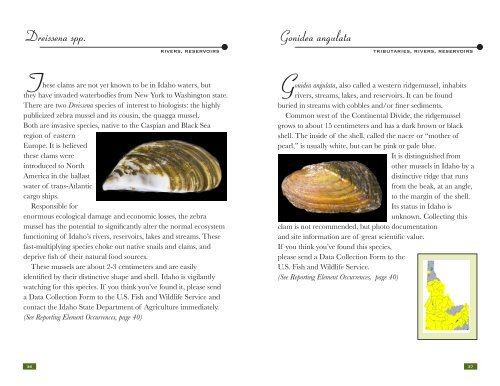Freshwater Mollusks - U.S. Fish and Wildlife Service
Freshwater Mollusks - U.S. Fish and Wildlife Service
Freshwater Mollusks - U.S. Fish and Wildlife Service
You also want an ePaper? Increase the reach of your titles
YUMPU automatically turns print PDFs into web optimized ePapers that Google loves.
Dreissena spp.<br />
T<br />
rivers, reservoirs<br />
hese clams are not yet known to be in Idaho waters, but<br />
they have invaded waterbodies from New York to Washington state.<br />
There are two Dreissena species of interest to biologists: the highly<br />
publicized zebra mussel <strong>and</strong> its cousin, the quagga mussel.<br />
Both are invasive species, native to the Caspian <strong>and</strong> Black Sea<br />
region of eastern<br />
Europe. It is believed<br />
these clams were<br />
introduced to North<br />
America in the ballast<br />
water of trans-Atlantic<br />
cargo ships.<br />
Responsible for<br />
enormous ecological damage <strong>and</strong> economic losses, the zebra<br />
mussel has the potential to significantly alter the normal ecosystem<br />
functioning of Idaho’s rivers, reservoirs, lakes <strong>and</strong> streams. These<br />
fast-multiplying species choke out native snails <strong>and</strong> clams, <strong>and</strong><br />
deprive fish of their natural food sources.<br />
These mussels are about 2-3 centimeters <strong>and</strong> are easily<br />
identified by their distinctive shape <strong>and</strong> shell. Idaho is vigilantly<br />
watching for this species. If you think you’ve found it, please send<br />
a Data Collection Form to the U.S. <strong>Fish</strong> <strong>and</strong> <strong>Wildlife</strong> <strong>Service</strong> <strong>and</strong><br />
contact the Idaho State Department of Agriculture immediately.<br />
(See Reporting Element Occurrences, page 40)<br />
Gonidea angulata tributaries, rivers, reservoirs<br />
G onidea angulata, also called a western ridgemussel, inhabits<br />
rivers, streams, lakes, <strong>and</strong> reservoirs. It can be found<br />
buried in streams with cobbles <strong>and</strong>/or finer sediments.<br />
Common west of the Continental Divide, the ridgemussel<br />
grows to about 15 centimeters <strong>and</strong> has a dark brown or black<br />
shell. The inside of the shell, called the nacre or “mother of<br />
pearl,” is usually white, but can be pink or pale blue.<br />
It is distinguished from<br />
other mussels in Idaho by a<br />
distinctive ridge that runs<br />
from the beak, at an angle,<br />
to the margin of the shell.<br />
Its status in Idaho is<br />
unknown. Collecting this<br />
clam is not recommended, but photo documentation<br />
<strong>and</strong> site information are of great scientific value.<br />
If you think you’ve found this species,<br />
please send a Data Collection Form to the<br />
U.S. <strong>Fish</strong> <strong>and</strong> <strong>Wildlife</strong> <strong>Service</strong>.<br />
(See Reporting Element Occurrences, page 40)<br />
36 37

















